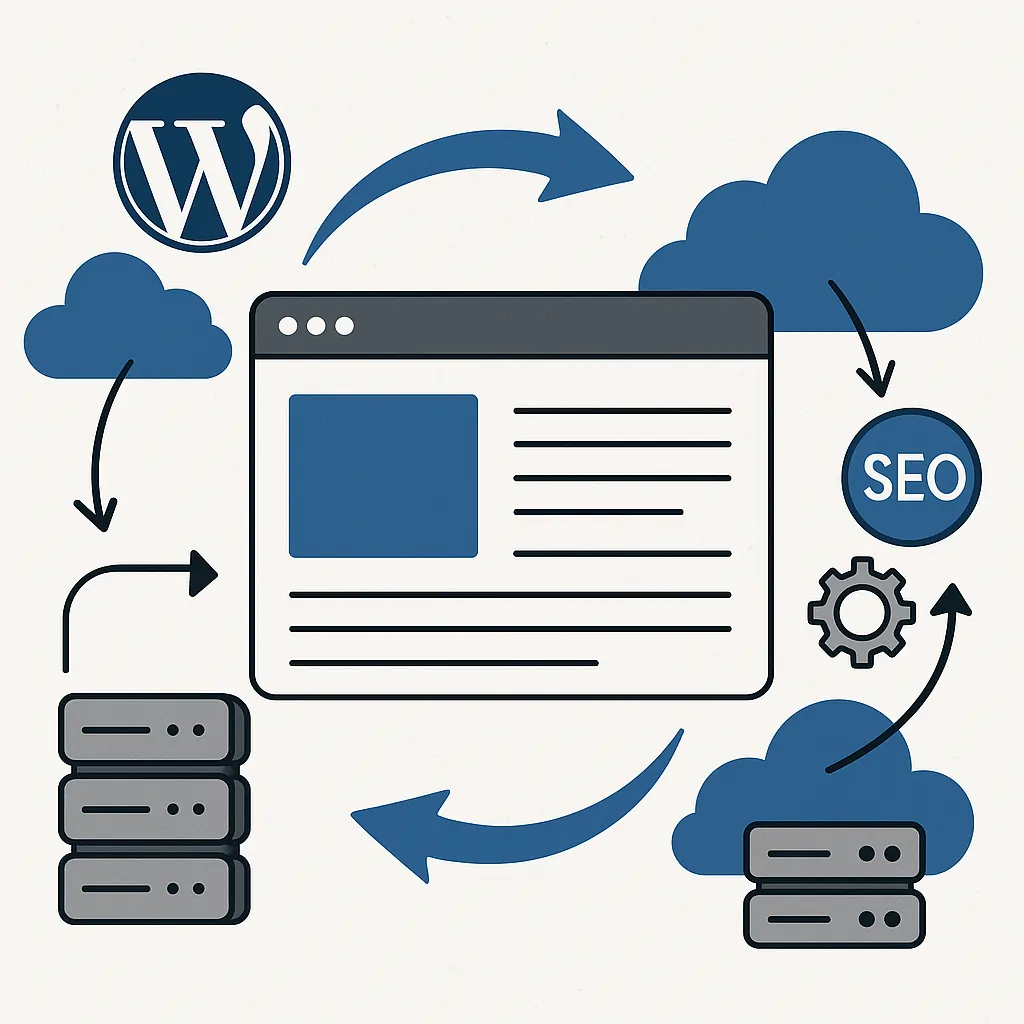🧭 WordPress Website Migration: How to Move Your Site Safely Without Losing SEO
WordPress website migration might sound simple — copy files, move the database, and you’re done. But in reality, a website migration requires precision, planning, and SEO awareness to avoid downtime, broken links, or ranking drops.
In this guide, I’ll explain how to migrate a WordPress website safely, what common mistakes to avoid, and how professional migration services can make the process smooth and stress-free.
🧱 What Is a WordPress Website Migration?
A WordPress website migration is the process of moving your entire website — files, database, content, and settings — from one environment to another. This could mean:
- Moving your site to a new web host
- Changing your domain name
- Migrating from a staging environment to live
- Moving from HTTP to HTTPS
- Or even changing the site structure or design
Every type of migration has its own technical challenges. Without proper execution, you could lose rankings, damage internal links, or even make your site temporarily inaccessible.
⚙️ Why Website Migration Must Be Done Carefully
When you move your website, you’re also moving your digital reputation.
A rushed migration can cause:
- ❌ Broken URLs and 404 errors
- ❌ Loss of SEO rankings due to missing redirects
- ❌ Downtime that affects user trust
- ❌ Corrupted files or databases
That’s why professional WordPress developers use structured migration checklists to ensure every step — from DNS propagation to permalink validation — runs smoothly.
🪜 Step-by-Step: How to Migrate a WordPress Website Safely
1. Backup Everything
Before you touch anything, create a full backup — files, themes, plugins, database.
Tools like UpdraftPlus or All-in-One WP Migration make this simple. Alternatively, a manual backup via cPanel or FTP ensures full control.
2. Choose the Right Hosting Environment
Migrating to a fast, secure, and reliable host is crucial. If your website is built for UK users, choose a UK-based hosting provider for better speed and GDPR compliance.
3. Move Your Files and Database
Transfer your files to the new server using FTP or SSH, then import your MySQL database via phpMyAdmin. Update the wp-config.php file with the new database credentials.
4. Update URLs and Search Links
If your domain changes, use Search Replace DB or WP-CLI to update all internal links, images, and serialized data.
5. Set Up 301 Redirects
If your URL structure changes, add 301 redirects from old pages to new ones. This tells Google your content has permanently moved — preserving your SEO equity.
🔗 Learn more: SEO Redirect Best Practices for WordPress
6. Reconnect Google Search Console & Analytics
Update your Search Console and Analytics with the new property or domain. Re-submit your sitemap to help Google crawl your new URLs faster.
7. Test Before Going Live
Before switching DNS records, check everything in a staging environment:
- Images load correctly
- Forms and contact pages work
- Plugins are active
- SSL is configured
8. Update DNS and Go Live
Once you’ve tested, point your domain to the new host. DNS propagation can take up to 48 hours — plan your launch outside peak business hours.
🚀 SEO Considerations During WordPress Migration
Website migration is not only a technical task — it’s also an SEO challenge.
To protect your organic traffic:
- Keep the same URL structure whenever possible.
- Submit a new XML sitemap immediately after migration.
- Monitor 404 pages via Search Console and fix them quickly.
- Maintain meta titles, descriptions, and canonical tags.
- Check internal links to prevent redirect chains.
If done properly, migration can even improve your SEO performance, especially if you’re moving to a faster host or SSL-secured site.
🧑💻 Why Hire a WordPress Migration Expert?
A professional WordPress developer can handle complex migrations — especially for WooCommerce or membership sites — where downtime or data loss can cost real money.
At Mihai Dobre – Freelance WordPress Developer UK, I offer:
- ✅ Full-site and WooCommerce migrations
- ✅ 0% data loss guarantee
- ✅ SEO and speed optimization included
- ✅ SSL and CDN setup
- ✅ Ongoing post-migration support
You focus on your business — I’ll handle the migration safely and efficiently.
🧩 Common WordPress Migration Mistakes (and How to Avoid Them)
- Skipping the backup — Always keep a copy of your old site for at least 30 days.
- Not checking broken links — Use Screaming Frog or Rank Math’s redirection tool.
- Forgetting SSL certificates — Without HTTPS, browsers will show “Not Secure.”
- Ignoring email setup — Update MX records if your emails are hosted with the same domain.
- Failing to test before DNS switch — Never go live without checking on a staging server.
📊 After the Migration: Monitor, Optimise, Improve
Once your site is live, spend the next few days monitoring:
- Google Search Console for crawl errors
- Page speed metrics in Google PageSpeed Insights
- Analytics traffic behaviour
Use this opportunity to improve site speed, UX, and SEO structure.
If you migrated to a better server or cleaner URL structure, you can expect a positive SEO impact within a few weeks.
🧠 Final Thoughts
Migrating a WordPress website is much more than copying files — it’s a strategic process that impacts your brand visibility, SEO, and user trust.
If you’re unsure about the technical side or don’t want to risk your rankings, hiring an experienced WordPress migration specialist in the UK is the smartest investment.
📞 Ready to Migrate Your WordPress Website?
I help UK businesses move their websites safely, fast, and SEO-ready.





kk45bet is growing on me. Nothing super fancy, but it’s solid. Withdrawals were processed quickly, which is always a win in my book! kk45bet
Lost the link to wowph? No problem! wowphlink saved the day. Easy access to the site without the fuss. Thanks! wowphlink